SIMILARITIES AND DIFFERENCES OF TIGER-CRANE SETS

Chinese Characters for “Tiger-Crane Double-Form Set”
Editorial Note: About 45 years ago in the 1970s, the most authoritative Chinese kungfu magazine then, “Xin Wu Xia” (“New Martial Hero”), published a series of articles with Sifu Wong's commentary on the Tiger-Crane Set. The series consists of four articles, namely:
- Similarities and Differences of Tiger-Crane Sets
- Combat Sequences of Tiger-Crane Set
- Miscellaneous Techniques of Tiger-Crane Set
- Training Methods of Tiger Claw
This article on “Similarities and Differences of Tiger-Crane Sets” is the first of the series. The sentence structure in this English translation follows that in the original Chinese version.
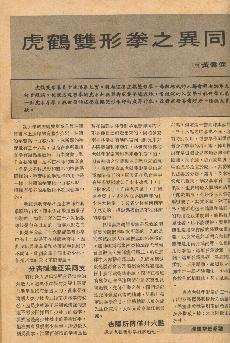
|
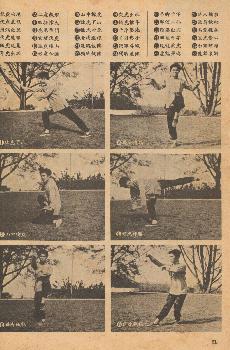
|
|
A page from the old kungfu magazine about the Tiger-Crane article |
A page from the magazine showing the 36 patterns and illustrations |
Similarities and Differences of Tiger-Crane Sets

A recent picture showing Sifu Wong demonstrating a Tiger pattern
The “Tiger-Crane Double-Form Set” (“Fu Hok Seong Yin Khuen” in Cantonese, “Hu He Shuang Xing Quan” in Mandarin) is a treasure of Shaolin Hoong Ka (Hung Gar) Kungfu. When talking about the Tiger-Crane Set, one is reminded of the great Hoong Ka master Wong Fei Hoong, who using the Tiger Claws and the No-Shadow Kicks derived from this set, was famous throughout the martial art circles of South China.
With the Tiger Claws, his inner-chamber disciple Lam Sai Weng was also well known through the martial art world. Lam Sai Weng's Tiger-Crane Set has been published as a book, and is a great contribution to martial art.
The Tiger-Crane Set that I have learnt is different in some ways from Sifu Lam's set as explained in the book. There are 108 patterns in Sifu Lam's set, but there are only 36 patterns in my set. But there are some patterns in the set that I have learnt, like “Catch a Tiger in the Mountains” and “White Crane Flaps Wings”, which are not found in Sifu Lam's set.
Nevertheless, most of the Tiger patterns and the Crane patterns are the same. The principles as well as application are also similar. As there are 108 patterns in Sifu Lam's set, naturally there are many patterns in his set not found in mine.
I believe my set is not derived from Sifu Lam's set. The reason is that if the set were a derivative, then the 36 patterns found in the off-spring set would be included in the 108 patterns of the mother set. Yet, in this 36 pattern set, there are 12 patterns not found in Sifu Lam's set. Hence, I believe these two sets came from the same tradition, but were passed on by different masters. Both came from Shaolin but had different development. (Please see Note below.)
Lineages of Harng Yein and Lok Ah Choy
Many people think that Hoong Hei Khoon was the founder of Hoong Khuen or Hoong Ka Kungfu. This, however, is a mistaken concept! Actually there was no founder for Hoong Ka Kungfu. Hoong Ka Kungfu is another name for Southern Shaolin Kungfu since the burning of the Shaolin Temple during the Qing Dynasty.
The reason was that Shaolin disciples did not use the term “Shaolin” so as to avoid the pursue of the Qing government. Hoong Hei Khoon was an outstanding exponent of southern Shaolin Kungfu, which he spread in Guangdong Province. Hence succeeding generations call the art Hoong Khuen, or Hoong Ka Kungfu.
The type of kungfu that Hoong Hei Khoon taught was what he had learnt at the Fujian Shaolin Temple from the Venerable Chee Seen, and not what he himself invented. There were also other masters spreading Southern Shaolin Kungfu, such as his classmates the Venerable Harng Yein and Loh Ah Choy.

A illustration from the magazine about 30 years ago showing Sifu Wong demonstrating “Fierce Tiger Descends Mountains”
Sifu Lam's Tiger-Crane Set was probably transmitted by Loh Ah Choy because Wong Fei Hoong's father, Wong Kai Ying, was Loh Ah Choy's outstanding disciple.
I believe my Tiger-Crane Set was transmitted by the Venerable Harng Yein because there are many patterns in my set, like “Catch a Tiger in the Mountains”, “Old Tree with Roots”, “Hungry Tiger Returns to Den”. “Lazy Tiger Stretches its Waist”, that are found in the special set of the Venerable Harng Yein, namely “Shaolin Great Foundation Set”, also known as “Essence of Shaolin”, but these patterns are not found in Sifu Lam's set.
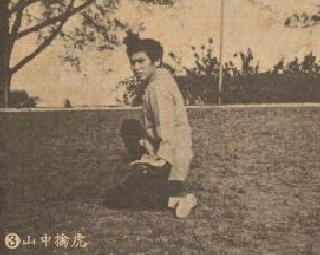
Sifu Wong demonstrating “Catch a Tiger in the Mountains”
My Tiger-Crane Set was transmitted to me by my first kungfu master, Sifu Lai Chin Wah. My master learnt it from the great Hoong Ka Kungfu master, Sigung Lu Chan Wai. Sigung Lu Chan Wai was the founder of Fok Kong Kungfu School in Penang, Malaysia. (Please see Note below.)
My master, Sifu Lai Chin Wah, was the second in the family. So many people from the martial art world respectfully called him “Yi Sook”, or Second Uncle. (Please see Note below.) My master taught for a few decades at the Fok Kong Kungfu School and the Soon Tuck Association Lion Dance Troupe. Numerous public figures in Penang also invited my master to their homes for private teaching.
When my master left this world, my classmates formed “Chin Wah Hoong Khuen Institute” to honour him. The well known public figure of Penang, Mr Lu Chor Fu was the president of the Institute, and my senior classmate, Wong Choy Wah, was the grandmaster.
NOTE:
Sifu Lai Chin Wah's honorific nickname was “Yi Sook”. The Chinese word “yi” has a few meanings, one of which is “two” or “second”.At the time the above article was published, Sifu Wong misinterpreted “Yi Sook” as “Second Uncle”. This mistake was pointed out to Sifu Wong by his senior classmate, Sifu Wong Choy Wah, the Grandmaster of Chin Wah Hoong Ka Kungfu Institute, who told Sifu Wong that “yi” here means “righteousness”, and “Yi Sook” means “Uncle Righteousness”.
Sifu Wong Choy Wah, being much older than Sifu Wong Kiew Kit and lived about the same time as Sifu Lai Chin Wah, also explained that the honorific nickname “Uncle Righteousness” was given to Sifu Lai Chin Wah by the public for his righteous manners in helping to solve problems for many people at a time when the fist rather than law was the rule of the day, reminiscent of the time of Wong Fei Hoong.Sifu Wong Choy Wah also told Sifu Wong that Uncle Righteousness learned from two other Shaolin masters, Sifu Ng Yew Loong and Sifu Chui Khuen, before learning from Sifu Lu Chan Wai, and he helped Sifu Lu Chan Wai to teach in his Fok Khong Kungfu School. It was possible that Sifu Lai Chin Wah had learnt this Tiger-Crane Set from Sifu Ng Yew Loong earlier, and taught this set at Sifu Lu Chan Wai's school.
Sifu Wong later discovered that Sifu Ng Yew Loong learned from Sifu Chan Fook, who learned Shaolin Kungfu at the Fujian Shaolin Temple probably from the Venerable Harng Yein. The Venerable Harng Yein was the most senior disciple of the Venerable Chee Seen, and a senior classmate of the famous Shaolin masters Hoong Hei Khoon and Loh Ah Choy.
36 Patterns Transmitted by the Venerable Harng Yein
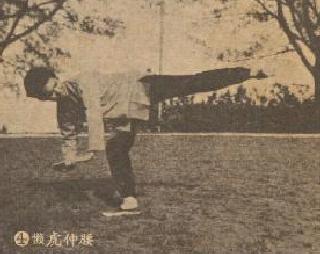
Sifu Wong demonstrating a Tiger-Tail Kick
Although this Tiger-Crane Set consists of only 36 patterns, it is a profound kungfu set. Every of the 36 patterns is different, and every one has its special application. It has both hard and soft dimensions, and include all the four major categories of combat, namely hitting, kicking, felling and qin-na (gripping). This set also includes the “Organ-Seeking Kick”, the “Clutch-Kick” and the “Tiger-Tail Kick” of the genre of Shaolin No-Shadow Kicks.
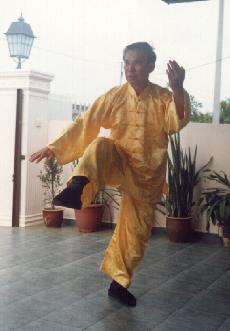
A recent photograph of Sifu Wong demonstrating a Crane pattern
The Tiger Form of this set emphasizes the Tiger Claw. Its characteristic is forcefulness and ferocity, and its applications are “separating sinews”, “wronging bones” and “gripping vital points”. To apply the Tiger Claw efficiently, the practitioner should train the force of Tiger Claw and understand joints, tendons and energy network.
Regarding the Crane Form many people think that it only consists of the Crane Beak. Actually this is not so. Besides the Crane Beak, the Crane Form also includes the Crane Wings and the Crane Legs.
The application of the Crane is to use “softness” to subdue hard force. When facing a huge and strong opponent, one should not meet force with force, but to use tactics. The Crane Beak is to strike at the opponent's weak points, like eyes, neck and vital points, such as the “ermen” vital point and the “qimen” vital point (behind the ears and beneath the rib cage).
The Crane Wings are manifested by the elbows and the arms. When an opponent is close, strike him with the elbow. This is “folding wings”. When you spread out our arms, this is called “spreading wings”. When “spreading wings”, use soft force, not hard force.
The Crane Legs manifest an important aspect of Shaolin No-Shadow Kicks. Shaolin kicks are usually low, seldom above the chest.
I list below the 36 patterns of the Tiger-Crane Set, with some illustrations. I hope this may serve as “throwing stones to attract jade” (giving crude comments to attract wise words from others), and hope that senior masters may bestow their advice.
The 36 Patterns of the Tiger-Crane Set
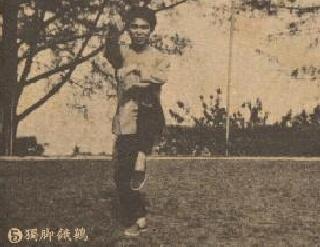
An old photograph of about 30 years showing Sifu Wong demonstrating a Crane pattern
- Long Fu Chiut Yin — Dragon and Tiger Appear
- Ye Fu Chong Choon — Two Tigers Hide Trace
- Fok Fu Chong Loong — Tame Tiger Hide Dragon
- Seai Chee Chang Thein — Four Fingers Piercing Sky
- Fei Hoong Chin Yik — Flying Bird Flaps Wings
- Fu Pang Chai Moon — Tiger Leans on Wooden Door
- Fok Fu Lein Chiu — Tame Tiger with String of Beads
- Yun Thian Fok Fu — God of Wealth Tames Tiger
- Ngo Fu Thui Chaw — Hungry Tiger Returns to Den
- Mang Fu Thui San — Fierce Tiger Pushes Mountains
- Than Fu Chuit Thoong — Single Tiger Emerges from Cave
- Lan Fu Sun Yew — Lazy Tiger Stretches its Waist
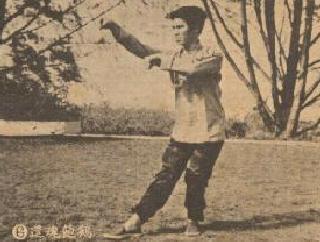
Another old photograph of Sifu Wong demonstrating “Reincarnated Satisfied Crane”
- San Choong Kam Fu — Catch a Tiger in Mountains
- Yeh Fu Chuit Lam — Night Tiger Emerges from Forest
- Mang Fu Ha San — Fierce Tiger Descends Mountains
- Ngo Fu Kam Yeong — Hungry Tiger Snatches Goat
- Mang Fu Wooi Yun — Fierce Tiger Returns to Highlands
- Chin Kein Choi Tieh — Thousand Tons to Ground
- Lou Shie Phwon Kein — Old Tree with Roots
- Yeit Yuit Yin Sau — Sun and Moon Cast Shadows on Hand
- Wan Wen Pao Hok — Satisfied Reincarnation Crane
- Ngo Hok Cham Ha — Hungry Crane Seeks Prawns
- Toik Keok Ngo Hok — Single Legged Hungry Crane
- Toik Keok Fei Hok — Single Legged Flying Crane
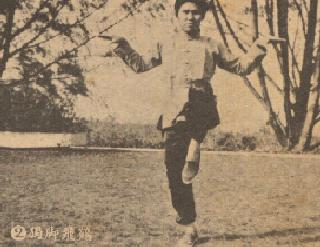
Sifu Wong demonstrating “Single Legged Flying Crane”
- Thiew Keok Chin Tze — False Leg Hand Sweep
- Sin Yen Chak Kai — Immortal Plucks Legume
- Chooi Chow Pat Xin — Drunken Eight Immortals
- Yu Yong San Mong — Fisherman Casts Net
- Lor Hon Chuit Tong — Lohan Emerges from Cave
- Wu Loong Pai Mei — Dark Dragon Wags Tail
- Wooi Tou Chin Tze — Return Head Hand Sweep
- Hak Fu Thow Sum — Black Tiger Steals Heart
- Yein Loong Chong Fu — Show Dragon Hide Tiger
- Pak Hok Leong Chi — White Crane Flaps Wings
- Fu Hok Chai Ming — Tiger and Crane Sound Together
- Loong Kwai Chuin Thoong — Dragons Return to Den
